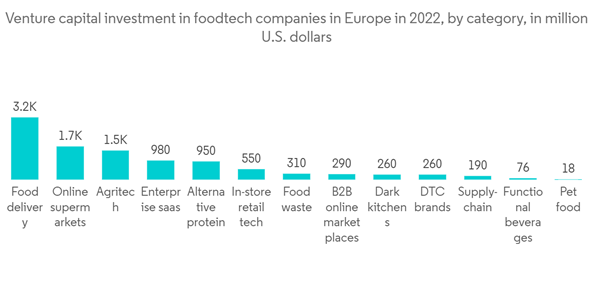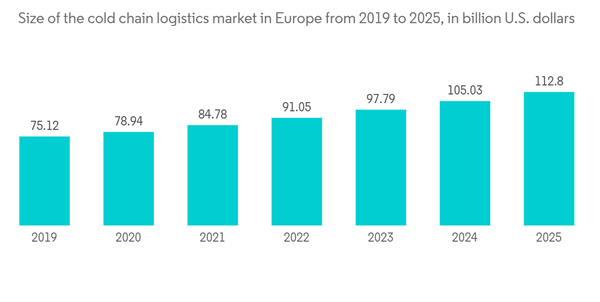In Europe, the market for cold chain services is expanding rapidly. A shift in the region's eating preferences has been a fundamental driver of the cold chain business in Europe.
The demand for fresh fruits and vegetables has steadily increased in Europe due to changes in consumer preferences and growth in health consequences. This led to an increase in the production and trade of fruits & vegetables, creating a need for efficient coal chain logistics. In addition, stringent regulations regarding food safety and quality standards have necessitated the use of cold chain logistics.
In January 2021, the European Union introduced new regulations to improve the quality and safety of organic products, which would impact the cold chain logistics for organic fruits and vegetables.
According to the Centre for the Promotion of Imports from Developing Countries (CBI), Europe has a population of more than 530 million consumers, and it accounted for more than USD 68.13 billion (EUR 62 billion), or 43% of the total global trade value of fresh fruit and vegetables in December 2022.
In addition, the European Union imported vegetable, fruit, and nut food preparations worth USD 6.96 billion in the year 2022, according to the United Nations COMTRADE database.
Furthermore, there has been an increase in focus on sustainability and reduction in the carbon footprint of cold chain logistics, leading to the development of eco-friendly solutions for preserving fruits and vegetables.
Europe Food Cold Chain Logistics Market Trends
Growth in penetration of the e-commerce industry
Consumers shifted to e-commerce channels by nearly 30 percent, accelerating the sector’s growth and creating challenges for traditional retailers, many of whom made significant investments to compete with pure-play online sellers.While Europe’s leading economies like Norway, the UK, Germany, and the Netherlands already have eCommerce penetration rates of around 80% and higher, there is a lot of potential still to be tapped in smaller economies in the South and East like Greece, Portugal or Poland. On average, 62% of consumers in Europe used online shopping channels in 2022.
The B2C E-commerce market has been divided into B2C retailers and classifieds. The B2C merchant's type sector is likely to dominate the region's market with a forecasted value of USD 7,971 billion by 2030, representing an annual growth rate of 8%.
The 2022 European E-commerce Report encompasses 37 countries on the European continent, revealing data-driven insights into the current and projected size of their digital markets and consumer trends in internet use and e-shopping. For 2023, a more than solid plus of almost 30% is forecast on a year-on-year basis.
Increasing Demand of Refrigerated Logistics from the Retail Industry
Refrigerated trucking is a type of freight transport that focuses on the transportation of goods such as food and groceries that must be transported in a temperature-controlled environment. A refrigeration unit is put into trailers that haul food and other products to maintain all products in their original pre-shipped condition.Refrigerated truck transportation can be utilized for a variety of products alongside foods that require temperature control. Other widely committed goods that rely on refrigerated shipping include plants, medications, and personal care products.
Germany is one of the largest markets for refrigerated vehicles in Europe. The country is a major importer & exporter of agricultural commodities and processed food & beverage products. The major export destinations from Germany are the US, France, the UK, and the Netherlands. The top import origins are the Netherlands, France, the US, and Italy. Germany primarily imports fruits & vegetables and dairy products.
Europe Food Cold Chain Logistics Industry Overview
The European food cold chain logistics market is highly fragmented, with a mix of global and regional players dominating the industry. Some of the key players in the market are Americold Logistics, Lineage Logistics (Preferred Freezer Services), Nichirei Corporation, and VersaCold Logistics Services.The cold chain industry offers several possibilities for both new and established firms to penetrate regions with significant export potential as well as those with fast-expanding domestic demand for frozen goods. To gain a solid footing in the global market, these companies are increasingly turning to growth, mergers, and acquisitions.
Additional Benefits:
- The market estimate (ME) sheet in Excel format
- 3 months of analyst support
This product will be delivered within 2 business days.










